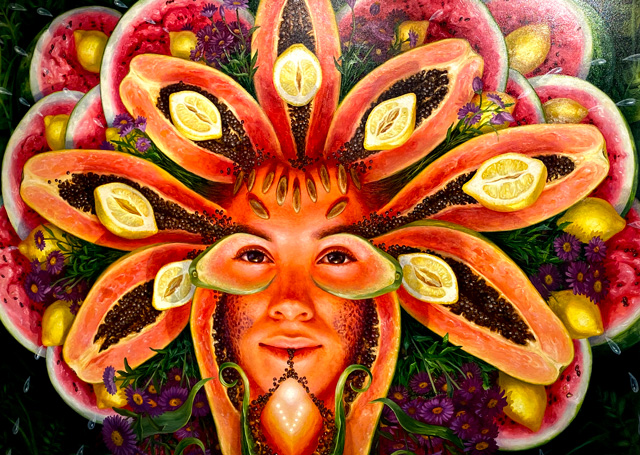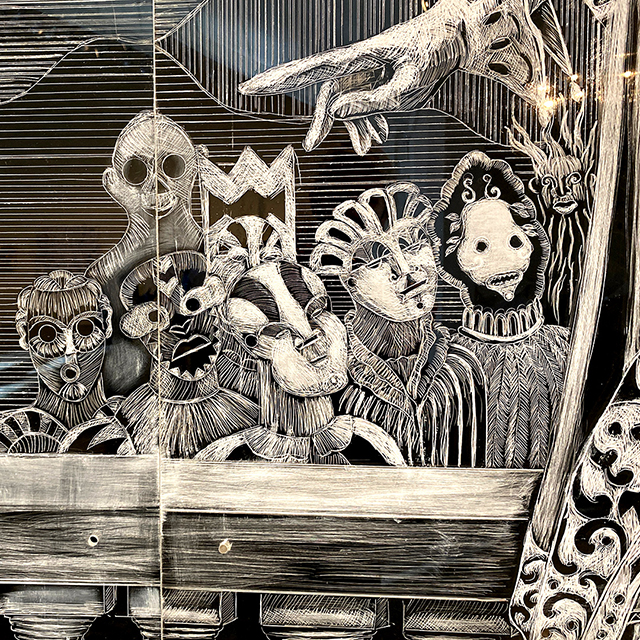Land of Full Maturity

By Megan Walls
Abya Yala: Structural Origins is an art exhibit featuring Latin American artists exploring the history of intellectual and cultural growth in the Americas. Abya Yala in the indigenous Kuna language means “Land of Full Maturity” and refers to the American contintent, say the organizers, who opened the exhibit at the Lehman College Art Gallery in September 2022. The show, featuring 20 artists, is part of the NY Latin American Art Triennial, an event that occurs every three years. Curators ask visitors to see in the exhibit links to the first inhabitants of the Americas, to “art that indigenous people made in creating mats, baskets, goldsmithing, pottery and textiles, all closely related to tapestry, and sculptures in clay, stone and metal.”
Renacer los Ancestros

Center stage in the gallery is a piece entitled “Renacer los Ancestros (Rebirth the Ancestors)” by artist Elizabeth Velazquez, who performed a ritual at the show opening to invoke “ancestor spirits through the activation of installation.” The ritual utilizes alcolado from malagueta leaves and mugwort to help participants connect with and “imagine their ancestors/guides or epiphanies in a way that feels right for them,” says Velazquez.
Ouija
Each of the artists provided a piece that resonated with his or her backgrounds and roots. Gabriel Grela Mesa’s piece, entitled “Ouija” (2021), reflects elements from his native Uruguay. Mesa visited places such as the International Museum of African Art in Uruguay, where he studied spiritual rituals. Mesa’s piece includes chicken bones, clay, a wooden head, silicone, acrylic paint and varnish. “Ritualistic communities in the Americas that existed before the arrival of African enslaved people began to absorb the myths, traditions and initiation rites that the Africans brought with them on their enforced journey,” says Mesa.

Papaya Crown
Chilean Alonsa Guevara’s piece, entitled “Papaya Crown” (2021) provided a burst of color in the gallery, with watermelon slices, cornflowers, lemons, and papaya emerging from a woman’s face. “By incorporating both fresh and vibrant produce with the rotten and blemished, my work represents the full cycle of life, making fertility and fecundity coexist in parallel with decay and death,” says Guevara. Her work is inspired by her childhood spent in the Ecuadorian rainforest, she says, “surrounded by tropical landscapes and diverse wildlife.”

King Henri and Haiti’s Royal Court
In contrast to Guevara’s colorful pieces, Haitian artist Edouard Duval-Carrie produced his plexiglass art in black and white. A 2019 piece entitled “King Henri and Haiti’s Royal Court” when closely viewed proves to be much more.

The work, an engraving on black plexiglass, shows the “decadence that suggest the unsavory aspects of King Henri’s reign,” says Duval-Carrie.

Memories of Tradition
Colombian artist Gabriel Correa took a more 3-D approach with his “Memories of Tradition” (2021). Set in the center of the gallery, his Picto-sculpture consisting of Bahareque (bamboo), hay, wood, plaster, earth and acrylic paint. Correa said the sculptures are “tributes to traditional architecture” which has been fading over time.

Neo-ancestral
Colectivo Daro is an Ecuadorian duo consisting of Dario Roman Fuela Valverde and Dario Xavier Sinche Brito. Their piece, “Neo-ancestral” (2021) looks like a wall of beer cans.

Up close, it is revealed that each piece is ceramic, carefully crafted to resemble a can using pre-Columbia and modern pottery techniques.

Ay Nicaragua
Melvin Toledo’s “Ay Nicaragua” (2019) is a political lament. “Latin America saw the arrival of the conquerors who subjugated their native peoples at the point of bullet and sword,” says Toledo. “They forced their language and religion and prohibited local customs.”

Nacimiento de Una Tierra
In “Nacimiento de Una Tierra (Birth of a Land)” (2022), Cuban Juan Carlos Alom documents an Abakuá initiation ceremony in black and white photography. Abakuá is an Afro-Cuban initiation from Nigeria and Cameroon. “The ceremony celebrates the strength of young men who seek to follow the principles of being a good man, a good son and a good friend, as well as an upstanding member of society that embraces high moral principles,” says Alom.

“Dragonfruit” (2019) and “Tutti Frutti – The Cookbook Series”
Argentina Lucia Fainzilber uses inkjet print on archival paper in “Dragonfruit” (2019) and “Tutti Frutti – The Cookbook Series,” her adaption and reinvention of the European still life. “The experience of migrating from my Argentina to New York City has become fertile ground for creativity and exploration, making me think about the idea of selfhood, identity and home in a foreign space,” says Fainzilber.


Mother and Resilience
Bolivian Cristian Laime Yujra’s “Mother and Resilience” (2019) is wrapped in plastic by her children, a reference to Mother Earth. “Faced with the disaster of filial detachment, her maternal instinct is constantly renewed and she finds in her existence the ways to remain fruitful, renewed, guardian and intelligent,” says Yujra.

Guna
In the wood sculpture “Guna” (2022), Puerto Rican artist Melquíades Rosario Sastre uses letters of the alphabet from the ancient Guna people of Mexico and Panama, along with Egyptian hieroglyphics.

The exhibit is runsTuesdays through Fridays 10 – 4pm until January 28, 2023.
Saved under Culture, Featured Slide, Multimedia
